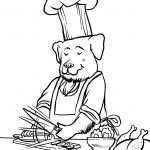Kibble is…
Kibble. When it comes right down to it, kibble is kibble. Nothing more, nothing less. And now that debate is raging everywhere about whether certain kibble causes cardiac disease in dogs, and whether to feed kibble with grains, without grains, and from which manufacturers, I feel compelled to explain this simple concept. Kibble is kibble.
It is not food. It is not chow. It’s not a meal, a dinner, or an entree. It’s not a “taste” of anything, or “a la veg.” It’s not “raw boosted” or “raw infused.” It’s kibble.


What is it then, if it is not any of the things listed above? It is a highly processed product, made largely from the waste of the human food industry, that is made into dog feed. Yes, I said feed, because that is the correct term for a product made to be fed to animals. If it were suitable for humans, it would be termed food.
There is a significant distinction between what is human quality (or to use the technical term, fit for human consumption), and what is not. At times, it’s downright scary – moldy, rotting ingredients. Rendered meats from diseased animals. And worse. The problem is, how can you tell, when you are looking at the above nuggets of brown and green, and sometimes orange and gold? And when you see the bags, with their pretty pictures?

Do you really think the salmon in the bag is like that beautiful hunk pictured? And the apples, they’re perfect aren’t they? Those cranberries look tasty too! Shame the bag contains less than 1% cranberries and apples. Sadly, the salmon is more likely heads and tails, and the predominate ingredient is the fish meal mentioned after it, which looks like this:

In fact, if pet feed really were food, this picture would not be able to be taken.

That’s an aisle at one of my local supermarkets. On the left, you can see cleaners of many types. Dish and laundry detergent, scented products, bleach, and such are on the left. Dog feed is on your right, in kibble and canned forms. Cat feed is further down. No human food is housed in an aisle with all these products. Even bath soap, shampoo and other healthy and beauty aids get their own section, away from human food. So why is it OK for pet feed to be so close to all these potentially toxic cleaners?
So, now that you know more about kibble, you are probably wondering why anyone is arguing about which ones to feed — who would want to feed their best friend a highly processed product made of substandard ingredients? And it doesn’t matter whether it is made from spent egg laying hens, dead dairy cows, salmon heads and tails, or kangaroo, kibble is kibble. Its ingredients are not fit for human consumption. It’s processed at high temperatures and sometimes pressure, multiple times. It is higher in starches than the dog needs. It is stored, shipped, and sold without regard to what it may come in contact with. It’s not handled as food, because it is not food. And that’s not acceptable for our pets.
Please comment on my Facebook page (will open in a new tab). And if you are looking for info on non-kibble feeding plans, check out the books in my Amazon reference list.
 Previous Post
Previous Post